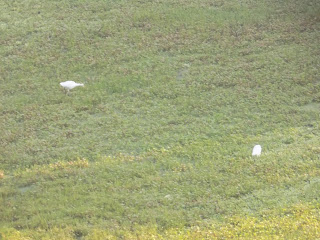Cattle Egret (Bubulcus ibis) உண்ணிக்கொக்கு
The cattle egret (Bubulcus ibis) is a cosmopolitan species of heron (family Ardeidae) found in the tropics, subtropics, and warm-temperate zones. It is the only member of the monotypic genus Bubulcus, although some authorities regard two of its subspecies as full species, the western cattle egret and the eastern cattle egret. Despite the similarities in plumage to the egrets of the genus Egretta, it is more closely related to the herons of Ardea. Originally native to parts of Asia, Africa, and Europe, it has undergone a rapid expansion in its distribution and successfully colonized much of the rest of the world in the last century.
Small, compact white heron with a relatively short yellow bill. More frequently seen in dry habitats than other egrets; rarely gets its feet wet. In, breeding season, look for pale salmon color on head and breast (more extensive in Asia and Australasia) and brighter bill. Leg color varies from reddish or yellow during the breeding season to black during the nonbreeding season. Juveniles have a dark bill. Always note relatively short, thick neck and short legs compared with other egrets. Widespread and fairly common across the globe. Often gathers in flocks, frequently following cattle or tractors in fields.
Scientific classification
Kingdom: Animalia
Phylum: Chordata
Class: Aves
Order: Pelecaniformes
Family: Ardeidae
Genus: Bubulcus Bonaparte, 1855
Species: B. ibis
Binomial name: Bubulcus ibis (Linnaeus, 1758)
On the Madambakkam Marshland area at 15th March 2021 more than 20 cattle egret were observed standing below a tree shade.
The Cattle Egret's feeding habitat is open country, where it is most often found associated with cattle (in North America). In other countries, it is found near a variety of large grazers. Breeding habitat is similar to that of other herons and egrets, in colonies near the water, often in a swamp or on an island.
The Cattle Egret eats mainly insects, especially grasshoppers, and in some parts of the world, parasitic flies. An adaptable species, they have been known to eat nestling birds and eggs, and to scavenge in dumps.
The Cattle Egret is a small heron, usually found near grazing mammals. Only half the size of a Great Egret, the Cattle Egret's size is a useful field mark. Juveniles and adults in non-breeding plumage are pure white with dark legs. Adults have yellow bills. The juvenile's bill is dark but turns yellow by its first fall. Adults in breeding plumage are unmistakable, with buff-colored plumes creating patches on the back, breast, and crest. Breeding adults also have orange bills and reddish-orange legs.












